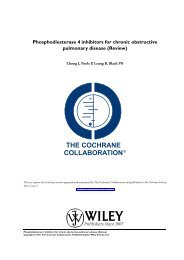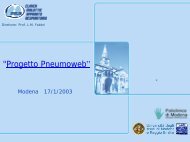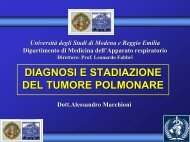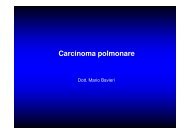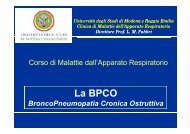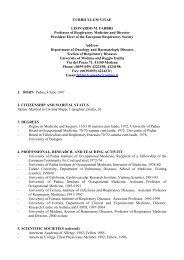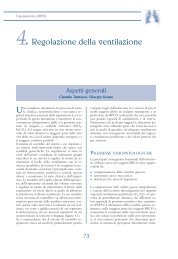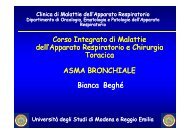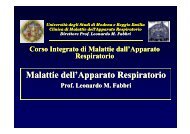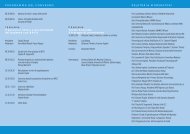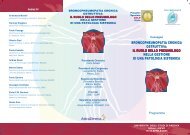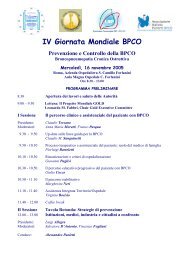2. - Clinica malattie apparato respiratorio
2. - Clinica malattie apparato respiratorio
2. - Clinica malattie apparato respiratorio
Create successful ePaper yourself
Turn your PDF publications into a flip-book with our unique Google optimized e-Paper software.
IL VOLTO DELLA BPCO CHE CAMBIA ● QUADERNO 2<br />
ree maggiormente pervie e riduce le resistenze al<br />
flusso nella BPCO, dall’altro essa ha importanti effetti<br />
negativi,soprattutto sui muscoli inspiratori 6 .Infatti,<br />
il lavoro di questi ultimi aumenta con l’aumentare<br />
del volume polmonare per contrastare l’elevata<br />
elasticità del tessuto parenchimale, specialmente<br />
nel tratto meno ripido della relazione pressione-volume<br />
(figure <strong>2.</strong>1, <strong>2.</strong>2, e <strong>2.</strong>4). Inoltre, a causa<br />
dell’aumento del volume polmonare i muscoli inspiratori<br />
si accorciano progressivamente e generano<br />
così meno pressione per un dato stimolo. Anche se<br />
in parte esiste un certo adattamento muscolare con<br />
riduzione del numero di sarcomeri in serie, l’aumentato<br />
carico lavorativo dei muscoli inspiratori e<br />
la loro ridotta capacità di generare forza in corso di<br />
iperdistensione polmonare possono essere fonte di<br />
dispnea e di fatica muscolare, che a lungo andare<br />
contribuiscono all’insorgenza di insufficienza respiratoria<br />
grave, soprattutto quando l’ostruzione delle<br />
vie aeree diventa severa. Ulteriori effetti negativi<br />
dell’iperdistensione polmonare si manifestano sui<br />
muscoli inspiratori e sull’<strong>apparato</strong> cardiocircolatorio<br />
quando essa si associa alla presenza di limitazione<br />
espiratoria al flusso 20 . Una loro trattazione più esauriente<br />
viene fatta in altra parte di questo capitolo.<br />
BIBLIOGRAFIA<br />
1. Agostoni E e Hyatt RE: Static behavior of the respiratory<br />
system. In Macklem PT, Mead J (Eds):<br />
Handbook of Physiology. The Respiratory System.<br />
Mechanics of breathing.Section 3,Vol 3,part 1.American<br />
Physiological Society,Bethesda 1986:113-130.<br />
<strong>2.</strong> Hoppin FG, Jr, Stothert JC, Jr, Greaves IA, Lai Y-L,<br />
Hildebrandt J: Lung recoil: elastic and rheological<br />
properties. In Macklem PT, Mead J (Eds): Handbook<br />
of Physiology. The Respiratory System. Mechanics<br />
of breathing. Section 3,Vol 3, part 1. American<br />
Physiological Society,Bethesda 1986:195-215.<br />
3. Quanjer PhH (Ed):Standardized Lung Function Testing.<br />
Lung Mechanics I: Lung Elasticity. Report<br />
Working Party Standardization of Lung Function<br />
Tests,European Community for Coal and Steel.Bull<br />
Europ Physiopath Respir 1983; 19(Suppl.5):28-3<strong>2.</strong><br />
4. Hyatt RE:Forced expiration.In Macklem PT,Mead<br />
J (Eds): Handbook of Physiology. Section 3,Vol 3,<br />
part 1. The respiratory system. Mechanics of<br />
breathing. American Physiological Society, Bethesda<br />
1986: 295-314.<br />
5. Rodarte JR e Rehder K: Dynamics of respiration.<br />
In Macklem PT, Mead J (Eds): Handbook of Physiology.<br />
The Respiratory System. Mechanics of<br />
breathing. Section 3,Vol 3, part 1. American Physiological<br />
Society, Bethesda 1986: 131-144.<br />
6. Pride NB e Macklem PT: Lung mechanics in disease.<br />
In Macklem PT, Mead J (Eds): Handbook of<br />
Physiology.The Respiratory System. Mechanics of<br />
breathing. Section 3,Vol 3, part <strong>2.</strong> American Physiological<br />
Society, Bethesda 1986: 659-69<strong>2.</strong><br />
7. Leith DE e Mead J: Mechanisms determining residual<br />
volume of the lungs in normal subjects. J Appl<br />
Physiol 1967; 23:221-227.<br />
8. American Thoracic Society: Lung function testing:<br />
selection of reference values and interpretative strategies.<br />
Am Rev Respir Dis 1991; 144:1202-1218.<br />
9. Quanjer PH,Tammeling GJ,Cotes FE,Pedersen OF,<br />
Peslin R, Yernault JC. Standardized lung function<br />
testing. Eur Respir J 1993; 6:1-99.<br />
10. Pellegrino R, Wilson O, Jenouri G, Rodarte JR:<br />
Lung mechanics during induced bronchoconstriction.<br />
J Appl Physiol 1996; 81:964-975.<br />
11. O’Donnell DE,Lam M,Webb KA:Spirometric correlates<br />
of improvement in exercise performance after<br />
anticholinergic therapy in chronic obstructive<br />
pulmonary disease. Am J Respir Crit Care Med<br />
1999; 160:542-549.<br />
1<strong>2.</strong> Pellegrino R, Rodarte JR, Brusasco V:Assessing the<br />
reversibility of airway obstruction. Chest 1998;<br />
114:1607-161<strong>2.</strong><br />
13. Babb TG,Viggiano R, Hurley B, Staats B, Rodarte<br />
JR:Effect of mild-to-moderate airflow limitation on<br />
exercise capacity. J Appl Physiol 1991; 70:223-230.<br />
14. Younes M: Determinants of thoracic excursions during<br />
exercise.In Whipp B,Wasserman K (Eds):Exercise:<br />
Pulmonary Physiology and Pathophysiology.<br />
Vol 5<strong>2.</strong> Marcel Dekker, New York 1991: 1-65.<br />
15. Konno K e Mead J: Measurement of the separate<br />
volume changes of rib cage and abdomen during<br />
breathing. J Appl Physiol 1967; 22:407-42<strong>2.</strong><br />
16. Gonzales H, Haller B,Watson HL, Sackner MA:Accuracy<br />
of respiratory inductive plethysmograph over<br />
wide range of rib cage and abdominal contribution<br />
to tidal volume in normal subjects and in patients<br />
with chronic obstructive pulmonary disease. Am<br />
Rev Respir Dis 1984; 130:171-174.<br />
17. Du Bois AB, Botelho SY, Bedell GN, Marshall R,<br />
Comroe JH Jr: A rapid plethysmographic method<br />
for measuring thoracic gas volume: a comparison<br />
with a nitrogen dilution method for measuring<br />
functional residual capacity in patients with respiratory<br />
diseases. J Clin Invest 1956; 35:322-326.<br />
18. Vinegar A, Sinnett EE, Leith DE: Dynamic mechanisms<br />
determine functional residual capacity in mice.<br />
Mus musculus. J Appl Physiol 1979; 46:867-871.<br />
14



